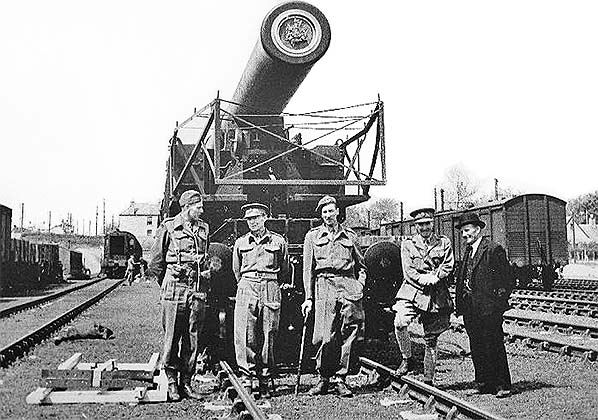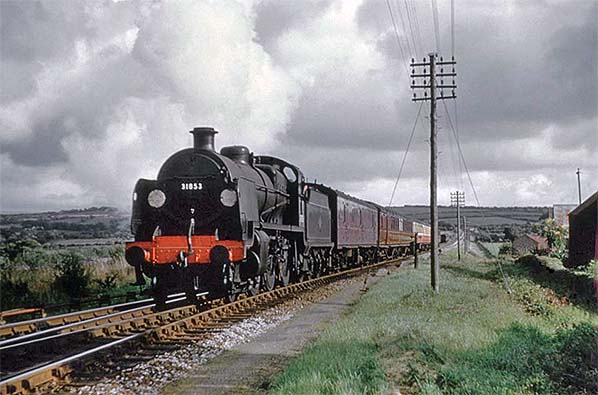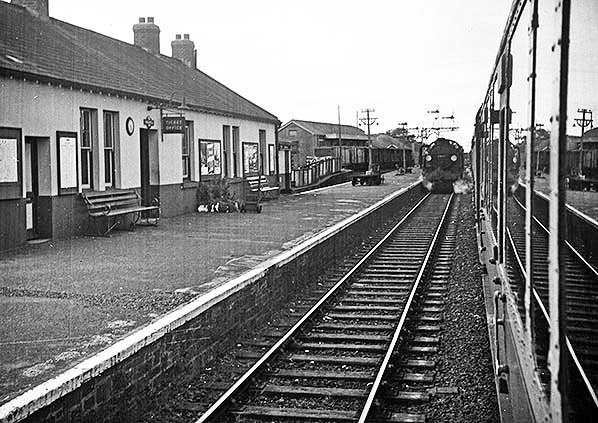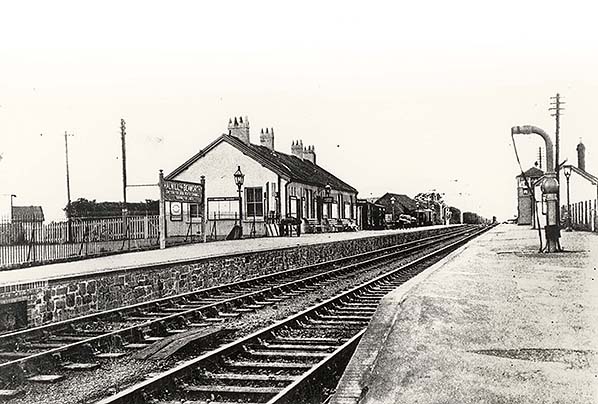
[Source:
Martin James]
Halwill Gallery 2: - 1930s - April 1963
 In preparation for the Second World War, eight sidings were laid on land to the south of Halwill station and on the up side. The reference point in this photograph is the Junction Hotel, left background. Seen here are army personnel, including two officers, and an official either from the Southern Railway or the War Department, posing for the camera in front of a rail-mounted gun. On the left one of the two diesel shunters used with the gun can be seen. For more details and pictures click here.
junction_old28.jpg) The Torrington bay at Halwill in September 1956. The locomotive, here being attended to by the driver, is an unidentified LMS-designed Ivatt 2-6-2T. A number of these useful little locomotives pottered around the Southern and were supplemented by the BR Standard versions. The train comprises a single Bulleid coach, perfectly adequate for the toddle to Torrington. The wooden walkway was for the benefit of locomotive crew but they could be quite slippery in wet weather as would appear to be prevailing in this view. The headcode was that for Bude so assuming the train was indeed going to Torrington then the same code must have applied to both lines; a very unusual situation where two separate routes met, as at Halwill. The disc position shown is known to have also applied to the Barnstaple Junction - Torrington section. Towards the left the bay's running-in board which displays 'Halwill Junction' can be seen. This name also once applied to the signal box whilst the main station is thought to have never been given the 'Junction' name insofar as its nameboards are concerned. At least 'Halwill Junction' is rather more accurate than 'Halwill for Beaworthy' as it related to the settlement of Halwill Junction which grew up adjacent to the station. No doubt the name of the Torrington bay had its origins in the line's independence from the Southern Railway. At the down platform of the main station a Drummond T9 is about to depart for Padstow and it will branch off westwards at a point to the right of the photographer but out of view from this angle.
Copyright photo by RM Casserley junction_old29.jpg) September 1956 and Drummond T9 No.30709 waits at Halwill with a train from Padstow. It is heading for Okehampton and perhaps Exeter. At the rear of the train, but shrouded in steam, is another locomotive, indicating that something is being attached to No.30709's train; see the picture below of this train departing. The person standing on the track is a shunter complete with pole. Shunter’s poles had a hooked end and were used to couple and uncouple stock. This was heavy work but once the knack of swinging the coupling was acquired it became second nature. Once the drawbar coupling was attached and slack taken up, if a screw coupling, it was then necessary to duck beneath the buffers and connect the pipework; vacuum; air; steam as applicable, set up the gangway connection, if any, and then open the relevant cocks and conduct a brake test. All this done, the tail lamp would be positioned and if all was well it was away we go. On the modern railway and insofar as passenger stock is concerned, the shunter’s pole is now a very rare sight. It will be noticed that the level crossing is open to the railway and in all probability had been so for several minutes. Such delays to road traffic were not uncommon and do still occur, the situation being dictated by interlocking between signals, points and level crossing which can be done only in a certain sequence. Back in 1956 road users, and there were much fewer of them than today, were more used to the gated level crossings which then proliferated and were in much less of a hurry. Halwill up starter signal is just out of view to the right. On the down side of the station, the bay platform is occupied by goods wagons and this appears to have been a frequent occurrence. The probable reason was the simplification of attaching and detaching wagons to or from through trains.
Copyright photo by HC Casserley junction_old32.jpg) Taken a few minutes after the previous view (above) showing No.30709 and the shunting operation, this view shows the same train on its way south from Halwill. What had been attached were two Conflat wagons with containers, these being just visible on the rear of the train. Conflats were 4-wheel flat wagons upon which were mounted various types and sizes of container. Readers of a certain age group will remember that British Railways branded the service 'Door To Door' for many years and that is precisely what it was. Containers were collected from the despatching customer by road vehicle, typically one of the various models of Scammell lorry with 3-wheel tractor unit, delivered to the local goods yard and loaded onto Conflat wagons. At the end of the rail journey containers would be delivered to recipients by the same means. Anybody, from private individuals to commercial organisations, could and did use the service but British Railways never considered the service profitable. In many ways the service was the forerunner of the Freightliner trains as introduced by Dr Beeching. Conflat wagons later found use as 'runners' for smaller diesel shunters such as Class 03 which could not be relied upon to operate track circuits on their own. The locomotive which attached the wagons at Padstow has probably retreated to the sidings out of view to the right.
Copyright photo by HC Casserley junction_old30.jpg) Still at Halwill on a wet and steamy day in September 1956 and viewed from the Torrington platform, by now vacated by the Ivatt tank and its single-carriage train. Some distance behind the camera was the run-round loop for the Torrington branch, this being operated via a ground frame unlocked from the signal box, but it is unclear if this was done electrically or by a key obtained from the box or by key attached to train staff. There was a connection from the Torrington branch to the up main line and trailing in the up main direction. At the up platform is what appears to be a BR Standard tank locomotive attaching a carriage to a train bound for Okehampton and beyond. The locomotive is displaying the headcode for the Torrington branch. At the down platform a T9 stands with a Padstow-bound train but is it thought not to be the same train as seen in another view taken on the same day. On the right a better view of the Conflat wagons and their containers is offered while the down bay platform is occupied by a rake of cattle wagons. The station has electric lighting with familiar Southern style standards as manufactured at the Southern Railway's Exmouth Junction concrete works. These were probably installed at Halwill in the mid to late 1930s.
Copyright photo by HC Casserley junction_old31.jpg) On the same damp day as other September 1956 views, we again see the train in the Torrington bay at Halwill, but even from this angle the Ivatt tank still cannot be identified thanks to its filthy condition. At the down platform a Drummond T9 is signalled away for the North Cornwall line to Padstow. As if to make the Ivatt feel at home, the T9 is also filthy but a larger version of this view suggests it is No.30717. This locomotive was a long-time resident of various sheds in the area, including Wadebridge, and was at Exmouth Junction from 1952 until withdrawal in the summer of 1961. On the right some Conflat wagons with containers can be seen.
Copyright photo by HC Casserley  Believed taken in 1959, Maunsell N class No.31853 has descended the gradient from Ashbury and will shortly pass over the level crossing and arrive at Halwill. She is negotiating the points for the two platform roads. No.31853 was transferred to Exmouth Junction (from Bricklayers Arms) in June 1959 so that would explain her relatively clean condition, Exmouth Junction's allocation usually being in filthy condition. There exists a perhaps understandable assumption that any locomotive-hauled passenger train carrying two headcode discs at Halwill is the ‘Atlantic Coast Express’ (ACE) but this could not be more wrong. The headcode, as seen here, applied to all passenger trains between Exeter and Padstow, Okehampton and Padstow or Halwill and Padstow in either direction. No.31853 could be working a portion of the ACE but it is more likely to be an Exeter or Okehampton - Padstow local which will divide at Halwill with the rear portion being forwarded to Bude. In the background beyond the rear of the train, two unidentified vehicles are stabled at the end of the rarely photographed siding on the up side of the line. This was No.1 siding, the loop which gave access to the wartime military sidings. It was here where in 1944 a points error caused a locomotive, which was getting up speed to storm the gradient, to demolish the buffers and end up on the Beaworthy Road. The train behind No.31853 is of particular interest. The first vehicle is a CCT van and further back are a couple of carmine and cream liveried Bulleid coaches while at the rear of the train is what looks like another van. It is the second and third vehicles in maroon livery which are interesting for they are an articulated pair. At first glance one may think they are either set 513 or 514, the sets converted from former steam rail-motors and one, at least, of which was at Exmouth Junction for a while but this was in 1951-52, long before this photograph was taken. Notwithstanding what appears to be a lavatory compartment in both cars, the set looks more like one of the ex-LNER Gresley steel-panelled articulated pairs which comprised a brake third and a lavatory composite. If so, then quite what it was doing in the West Country is a total mystery. Perhaps a reader who is expert in coaching stock will be able to provide more information.
Photo from Ted Burgess collection old69.jpg) Halwill on 21 April 1960 with the main subject being Ivatt 2MT tank waiting to depart with the 6.30pm service to Torrington. By this time this was one of only two weekday passenger trains on the Petrockstow - Halwill section, the other departing Halwill at 7.30am. These trains were considered as 'out and back' services from Torrington rather than Halwill and their timings may suggest that they ran primarily for the benefit of school children. The single carriage on this occasion was a Maunsell brake composite instead of the more usual Bulleid vehicle. Much Southern coaching stock was formed into numbered fixed sets and although these could be temporarily split as occasion warranted there were also a number of 'float' vehicles: single vehicles used as spares or for strengthening sets or for work such as Torrington - Halwill. At this time the Torrington bay running-in board still displayed 'Halwill Junction' and is believed to have been the only such board on Halwill station to have ever done so. By the time of closure, of the Torrington branch, the board announced simply 'Halwill' and appears to have been a replacement as opposed to a cut-down original. Either way, quite why the board was changed remains a mystery for, unless the original was in some way damaged, it was rather pointless. But BR tended to do such things and often at the whim of regional management. The locomotive is No.41297. The class totalled 130 examples and all bar the final ten were built at Crewe. No.41297 was from the final batch of 30 built at Crewe and which was intended for use on the Southern Region. This batch, Nos.41290 - 41319, was thus provided from new with irons for the six-position Southern lamp/headcode disc system. New in October 1951, No.41297 ended up at the relatively obscure shed at Radipole, Weymouth, from where she was withdrawn in October 1963 after a pathetically short life of exactly, to the month, 12 years. Just four of the class survived into preservation, which is a pity as the type is ideal for heritage railway use. Another train is present in the above scene, a short goods at the up platform. It is presumably waiting for a down train to clear the single-line section. The level crossing gates are closed to the railway, suggesting that the goods has a lengthy wait. Passenger trains, by nature of single-track junction stations, tended to pass and/or connect at Halwill during intermittent bursts of activity so seeing the level crossing closed to the railway with a train in the up platform was fairly unusual and probably mainly occurred, as here, with goods trains. The goods locomotive is largely obscured but from what can be seen it appears to be a T9 4-4-0.
Photo by Roger Joanes  The view from a carriage window at Halwill on an unknown date in 1961. Precisely what is happening is something of a puzzle and not helped by knowing only the year. An enlargement of this photograph tells us that the station clock is showing 5.29 and this will be p.m. Bradshaw for 6 March - 2 April 1961 suggests the train on the right will be the 3.13pm ex-Padstow which arrived at Halwill 5.20 and departed at 5.26 for Exeter St David's (Monday - Friday) or Okehampton (Saturday only). However, the length of the train and the N class locomotive on the down line suggests a Bude portion has been attached but the Bradshaw edition quoted shows no service arriving from Bude at this time. Thus, whilst the train on the right can be assumed to be the 3.13pm ex-Padstow, the photograph most likely dates from the 1961 summer timetable period. The N class locomotive appears to be No.31847 but it is by no means clear. It is interesting to note, or horrifying depending upon one's point of view, that the 49¾-mile journey between Padstow and Halwill occupied an average of two hours. Such were the problems with single-track routes with numerous intermediate stations and passing loops. Admittedly some journeys are not a great deal better today but back in the 1960s when government propaganda led people to believe the private car was the future it is no wonder, especially when intervals between train services were long, that people abandoned the railways and turned to road transport. In fairness, the roots of this problem harked back to when the railways were built during the Victorian era, a time when travel over any distance involved no alternative other than horses or on foot. Nevertheless, given the slow and infrequent train services it is possibly thanks only to the ‘Atlantic Coast Expres’s and the then pro-British holiday trade that Halwill remained open for as long as it did.
Photo from DK Jones collection junction_old33.jpg) A relaxing moment, for some, at Halwill's Torrington bay platform in June 1962 as the crew of Ivatt 2MT No.41294 take a break on the platform bench. The Ivatt was a resident of Barnstaple Junction shed at this time, which is also where the crew would have been based. By virtue of the line to Torrington being a light railway, the hopelessly infrequent services to and from Halwill were leisurely affairs taking not far short of one-and-a-half hours for the journey of a little over 20 miles. There were also some additional and equally infrequent services between Torrington and Petrockstow, these taking over half an hour to cover the eight miles. In the background an N class locomotive is about to take the North Cornwall line towards Launceston and Padstow with at least two parcels vans in-tow. Shadows tell us the photograph was taken in the morning, which means the departing train will be the 10.28 (ex-Okehampton 9.56) service to Padstow and the Ivatt will depart with the 10.38 to Torrington. Miss this train and you would have to wait eight hours for the next! On the Bude line, a BR Standard 4MT tank is seen and this will have been involved in shunting joining and dividing portions and, in all probability, in connection with the train seen here departing. For many years there was usually a locomotive lurking at Halwill for this purpose and in between such duties would be shunting in the goods yard or undertaking a local goods or passenger trip to Bude. It was in effect the Halwill pilot locomotive. On the down side, and beyond the junction with the North Cornwall line, was a short siding. Magnification of this view shows what appears to be a rake of open wagons on this siding, possibly condemned and awaiting scrap. 'Condemned' is a railway term for withdrawn and awaiting disposal. Once a very common sight, vehicles so assigned were marked either with a white circle containing an 'X' or simply with the abbreviation 'COND'.
junction_old15.jpg)
Looking south along Halwill's down platform on Saturday 20 April 1963. Maunsell N class No.31847 has arrived with the 09:56am Okehampton - Padstow which comprised a parcels van and four passenger coaches, the rear pair being detached and forwarded to Bude. Operations occupied several minutes and the photographer informs us the Bude portion was timetabled to depart at 10:33 while he then travelled on the 10:38 to Torrington. On the left is 'P set' No.25 which had arrived from Padstow. The goods dock is seen on the far right opposite the bay platform.
Photo by Brian Johnson junction_old16.jpg) Halwill looking north on Saturday 20 April 1963. Maunsell N class No.31847 has arrived with the 09.56am ex-Okehampton to Padstow service. As described with another same-day image, this train will split into Padstow and Bude portions with the latter being taken forward by a Standard 4MT tank. Halwill looking north on Saturday 20 April 1963. Maunsell N class No.31847 has arrived with the 09.56am ex-Okehampton to Padstow service. As described with another same-day image, this train will split into Padstow and Bude portions with the latter being taken forward by a Standard 4MT tank.Photo by Brian Johnson Click here for Halwill Gallery 3: April 1963 - 1964
|

 A view, probably from a postcard, looking north along Halwill's up platform. If it were not for the noticeboard on the side of the station building being headed ' Southern Railway', it would be difficult to allocate a period to this view. We can date it to the 1931-40 period as one photograph with a known date of 1931(above) showing oil lighting, as seen here, still in position and this was replaced with electric lighting sometime during that decade and possibly in 1935 as the Southern undertook a number of such modernisations during the year. Of possible interest to modellers might be the water column on the right, complete with brazier to prevent freezing during the winter. The lower section of the column is quite ornate but the overall appearance is rather ugly. Later this column was either modified or replaced, it is unclear which, and ended up even more hideous, while in later years it had come to lean very noticeably towards the platform edge. Water columns, or water cranes if a moveable boom was fitted, were of course functional devices but nevertheless many, especially the crane type, had a certain charm about them. Many remained in use beyond the end of steam in some areas due to the need to replenish the steam heating boilers originally installed in main line diesel locomotives. Heritage railways excepted, a small number continue in use today at depots and servicing points which handle main line registered steam locomotives but otherwise they are relics of a bygone age.
A view, probably from a postcard, looking north along Halwill's up platform. If it were not for the noticeboard on the side of the station building being headed ' Southern Railway', it would be difficult to allocate a period to this view. We can date it to the 1931-40 period as one photograph with a known date of 1931(above) showing oil lighting, as seen here, still in position and this was replaced with electric lighting sometime during that decade and possibly in 1935 as the Southern undertook a number of such modernisations during the year. Of possible interest to modellers might be the water column on the right, complete with brazier to prevent freezing during the winter. The lower section of the column is quite ornate but the overall appearance is rather ugly. Later this column was either modified or replaced, it is unclear which, and ended up even more hideous, while in later years it had come to lean very noticeably towards the platform edge. Water columns, or water cranes if a moveable boom was fitted, were of course functional devices but nevertheless many, especially the crane type, had a certain charm about them. Many remained in use beyond the end of steam in some areas due to the need to replenish the steam heating boilers originally installed in main line diesel locomotives. Heritage railways excepted, a small number continue in use today at depots and servicing points which handle main line registered steam locomotives but otherwise they are relics of a bygone age.
 Home Page
Home Page